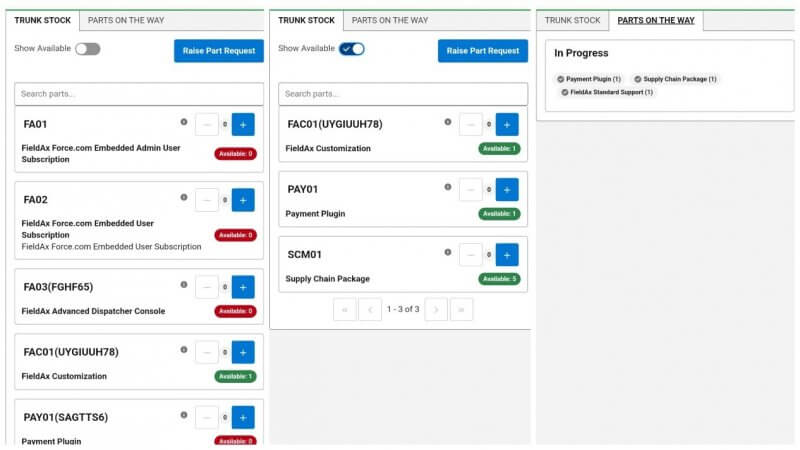In field service organizations, managing inventory and assets efficiently is crucial to ensure smooth operations, reduce costs, and improve customer satisfaction. This blog post will provide insights on how to effectively manage field service inventory and assets, covering key topics such as inventory tracking, asset maintenance, and optimizing supply chain operations.
Key Takeaways:
- Efficient inventory and asset management are essential for field service organizations to ensure smooth operations, reduce costs, and improve customer satisfaction.
- Utilizing inventory tracking software can enhance accuracy, efficiency, and cost savings by streamlining inventory control processes.
- Implementing asset management best practices such as regular maintenance and asset tracking helps optimize asset utilization and performance.
- Real-time visibility of inventory facilitates informed decision-making, prevents stockouts, and enhances operational efficiency.
- Preventative maintenance strategies help minimize downtime, extend equipment lifespan, and save on costly repairs, contributing to overall operational efficiency.

Inventory Tracking Software
Inventory tracking software plays a crucial role in streamlining the inventory management process for field service organizations. By utilizing specialized software tools, companies can optimize their inventory control, enhance efficiency, and reduce costs.
Benefits of Using Inventory Tracking Software for Field Service Organizations
- Improved Accuracy: Inventory tracking software eliminates manual errors and ensures accurate inventory data.
- Enhanced Efficiency: Streamlined workflows and automated processes save time and increase productivity.
- Real-Time Insights: Access to real-time inventory information allows for better decision-making and resource allocation.
- Cost Savings: Reduced stockouts, overstocking, and obsolete inventory lead to cost savings for the organization.
- Compliance: Inventory tracking software helps organizations comply with industry regulations and standards.
Asset Management Best Practices
Managing assets effectively is crucial for field service organizations to ensure optimal performance and efficiency. Here are some best practices for asset management:
- Regular Maintenance: Implement a scheduled maintenance program to ensure that assets are properly maintained and in good working condition.
- Asset Tracking: Use inventory tracking software to track the location and status of assets in real-time.
- Asset Identification: Label assets with unique identifiers such as barcodes or RFID tags for easy identification and tracking.
- Inventory Audits: Conduct regular audits to verify the accuracy of asset data and identify any discrepancies.
By following these best practices, field service organizations can ensure that their assets are well-managed and contribute to overall operational efficiency.
Real-Time Visibility of Inventory
Real-time visibility of inventory is crucial for effective decision-making in field service organizations. By having up-to-date information on inventory levels and location, managers can make informed decisions that can improve operational efficiency and customer satisfaction.
Benefits of having real-time inventory visibility for field service organizations:
- Improved inventory accuracy
- Reduced stockouts and overstock situations
- Enhanced customer service through timely fulfillment of orders
- Optimized inventory carrying costs
- Better forecasting and planning for future inventory needs
Preventative Maintenance Strategies
Preventative maintenance strategies are essential for managing field service assets effectively. By implementing proactive maintenance practices, businesses can minimize downtime, extend the lifespan of equipment, and ultimately save on costly repairs and replacements.
Proactive maintenance involves regularly scheduled inspections, cleaning, and servicing of equipment to identify and address issues before they escalate into more significant problems. By staying ahead of potential issues, businesses can ensure that their assets are operating at peak performance levels and avoid unexpected downtime that can disrupt operations.
Additionally, preventative maintenance strategies can help businesses maximize the return on investment for their assets by ensuring they are well-maintained and functioning optimally throughout their useful life.
By incorporating preventative maintenance strategies into their field service inventory management practices, businesses can reduce the risk of equipment failures, minimize repair costs, and improve overall operational efficiency.
Barcode and RFID Technology
Barcode and RFID technology play a crucial role in tracking inventory and assets in field service operations. These technologies provide a streamlined and efficient way to manage and monitor your inventory in real-time.

Overview of Barcode and RFID Technology
Barcode technology involves the use of printed labels that contain unique codes. These codes can be scanned using barcode scanners to identify and track individual items within your inventory. On the other hand, RFID (Radio Frequency Identification) technology uses radio waves to transmit data from RFID tags to RFID readers, allowing for quick and accurate inventory management.
Benefits of Using Barcode and RFID Technology
- Improved Accuracy: Barcode and RFID technology eliminate human error by automating the process of inventory tracking.
- Increased Efficiency: With barcode and RFID technology, field service technicians can quickly locate and retrieve the necessary parts and assets, saving time and improving productivity.
- Enhanced Visibility: Real-time data provided by barcode and RFID technology gives you better visibility of your inventory levels, helping you make informed decisions and prevent stockouts.
- Cost Savings: By reducing manual labor and minimizing the risk of lost or misplaced inventory, barcode and RFID technology help save on operational costs in the long run.
Mobile Inventory Management Solutions
Field service technicians often find themselves on the move, traveling from one job site to another throughout the day. The need for efficient inventory management solutions that can keep up with their fast-paced work environment has led to the development of mobile inventory management solutions.
These solutions are designed to allow technicians to access inventory data, update quantities, and track asset locations all from their mobile devices. By providing real-time information at their fingertips, technicians can make more informed decisions and streamline their inventory management processes.
Some key features of mobile inventory management solutions include:
- Barcode and QR code scanning: Technicians can quickly scan items to update inventory levels and track asset locations.
- Offline capabilities: In areas with limited connectivity, technicians can still access and update inventory data on their devices.
- Integration with back-end systems: Mobile solutions can sync with existing inventory management software to ensure data consistency across platforms.
Benefits of using mobile inventory management solutions for field service technicians include increased efficiency, reduced inventory errors, and improved customer satisfaction. By having accurate and up-to-date inventory information on the go, technicians can provide faster service and avoid delays due to missing or misplaced items.
Field Service Technicians’ Role in Inventory Tracking
Field service technicians play a crucial role in the inventory tracking processes of any organization. They are on the front lines, directly interacting with inventory and assets, making them vital to ensuring accurate and efficient management of resources.
Here are some ways field service technicians can help optimize inventory management:
- Accurate Reporting: Field service technicians are responsible for reporting any discrepancies or issues with inventory levels. Their timely and accurate reporting helps prevent stockouts or overstock situations.
- Inventory Auditing: Field service technicians can conduct regular audits of inventory to ensure that physical counts match what is recorded in the system. This helps identify any discrepancies and allows for timely corrective action.
- Asset Tracking: Field service technicians can use barcode or RFID technology to track assets in real-time, providing visibility into asset locations and status. This helps prevent loss or theft of assets.
- Collaboration: Field service technicians can collaborate with inventory managers and other team members to share insights and best practices for optimizing inventory levels and processes.
Inventory Optimization Techniques
When it comes to managing field service inventory and assets, optimizing your inventory is crucial for maximizing efficiency and productivity. By implementing inventory optimization techniques, you can streamline your operations and ensure that you have the right parts and equipment on hand when you need them.
Overview of inventory optimization techniques for maximizing efficiency
- Forecast Demand: By using historical data and predictive analytics, you can forecast demand for specific parts and equipment, helping you maintain optimal inventory levels.
- ABC Analysis: Classify your inventory into categories based on importance, with category A items being the most critical. This helps you prioritize and allocate resources effectively.
- Vendor Management: Build strong relationships with your vendors to improve lead times, reduce costs, and ensure that you have access to high-quality parts and equipment.
- Just-In-Time Inventory: Utilize a just-in-time inventory system to minimize carrying costs and reduce the risk of overstocking or stockouts.
Benefits of implementing inventory optimization techniques in field service organizations
- Improved Efficiency: By optimizing your inventory, you can reduce waste, minimize stockouts, and improve overall operational efficiency.
- Cost Savings: With better inventory management practices in place, you can reduce carrying costs, lower overhead expenses, and improve your bottom line.
- Enhanced Customer Satisfaction: By having the right parts and equipment on hand when you need them, you can improve service delivery and ensure customer satisfaction.
Cost-Effective Inventory Management Strategies
As a field service organization, managing inventory and assets efficiently is crucial to your success. Not only does effective inventory management improve service delivery and customer satisfaction, but it can also help reduce costs and increase profitability. Here are some cost-effective strategies to help you optimize your inventory management processes:
- Optimize Inventory Levels: Regularly analyze your inventory levels to ensure you have the right amount of stock on hand. Overstocking can tie up capital and lead to excess costs, while understocking can result in lost sales and unhappy customers.
- Implement Just-in-Time Inventory: Utilize the just-in-time inventory management approach to minimize holding costs and reduce the risk of obsolete inventory. By receiving inventory only when it is needed, you can lower storage costs and improve cash flow.
- Utilize Inventory Forecasting: Use inventory forecasting tools to predict demand and trends, allowing you to make informed decisions about inventory replenishment and avoid stockouts. This can help reduce excess inventory and improve inventory turnover.
- Streamline Inventory Processes: Automate manual inventory processes to save time and reduce errors. By implementing streamlined workflows and utilizing inventory tracking software, you can improve accuracy and efficiency in inventory management.
- Implement Vendor Managed Inventory (VMI): Partner with suppliers to implement vendor managed inventory, allowing them to monitor and replenish your inventory levels. This can help reduce lead times, inventory holding costs, and stockouts.
See how FieldAx can transform your Field Operations.
Try it today! Book Demo
You are one click away from your customized FieldAx Demo!
Conclusion
Managing field service inventory and assets is crucial for the success of any organization. By implementing inventory tracking software, following asset management best practices, utilizing real-time visibility of inventory, implementing preventative maintenance strategies, leveraging barcode and RFID technology, adopting mobile inventory management solutions, involving field service technicians in inventory tracking, utilizing inventory optimization techniques, and implementing cost-effective inventory management strategies, organizations can streamline their operations and improve efficiency.
It is essential for field service organizations to prioritize inventory and asset management to ensure smooth operations and customer satisfaction. By investing time and resources into proper inventory and asset management, organizations can reduce costs, optimize inventory levels, and ultimately improve their bottom line.
Make inventory and asset management a top priority for your field service organization to achieve operational excellence.
FAQs (Frequently Asked Questions)
1. Why is efficient inventory and asset management important for field service organizations? Efficient inventory and asset management are crucial for field service organizations to ensure smooth operations, reduce costs, and enhance customer satisfaction. Proper management helps in maintaining optimal inventory levels, minimizing stockouts, and maximizing asset utilization.
2. What are some benefits of using inventory tracking software for field service organizations? Inventory tracking software offers various benefits, including improved accuracy, enhanced efficiency, real-time insights, cost savings, and compliance with industry regulations. These tools streamline inventory control, automate processes, and provide valuable data for decision-making.
3. How can field service organizations optimize asset management? Field service organizations can optimize asset management by implementing regular maintenance schedules, utilizing asset tracking technology, labeling assets for easy identification, and conducting inventory audits. These practices ensure assets are well-maintained and contribute to operational efficiency.
4. What is the significance of real-time visibility of inventory for field service organizations? Real-time visibility of inventory enables field service organizations to make informed decisions, prevent stockouts, enhance customer service, optimize inventory carrying costs, and improve forecasting. Access to up-to-date information facilitates efficient resource allocation and decision-making.
5. How do preventative maintenance strategies benefit field service organizations? Preventative maintenance strategies help field service organizations minimize downtime, extend equipment lifespan, and save on costly repairs. By implementing proactive maintenance practices, businesses can identify and address issues before they escalate, ensuring optimal asset performance.
Author Bio
Co-Founder & CMO at Merfantz Technologies Pvt Ltd | Marketing Manager for FieldAx Field Service Software | Salesforce All-Star Ranger and Community Contributor | Salesforce Content Creation for Knowledge Sharing






